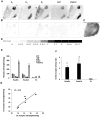Dopamine D1, D2, D3 receptors, vesicular monoamine transporter type-2 (VMAT2) and dopamine transporter (DAT) densities in aged human brain
- PMID: 23185343
- PMCID: PMC3504049
- DOI: 10.1371/journal.pone.0049483
Dopamine D1, D2, D3 receptors, vesicular monoamine transporter type-2 (VMAT2) and dopamine transporter (DAT) densities in aged human brain
Abstract
The dopamine D(1), D(2), D(3) receptors, vesicular monoamine transporter type-2 (VMAT2), and dopamine transporter (DAT) densities were measured in 11 aged human brains (aged 77-107.8, mean: 91 years) by quantitative autoradiography. The density of D(1) receptors, VMAT2, and DAT was measured using [(3)H]SCH23390, [(3)H]dihydrotetrabenazine, and [(3)H]WIN35428, respectively. The density of D(2) and D(3) receptors was calculated using the D(3)-preferring radioligand, [(3)H]WC-10 and the D(2)-preferring radioligand [(3)H]raclopride using a mathematical model developed previously by our group. Dopamine D(1), D(2), and D(3) receptors are extensively distributed throughout striatum; the highest density of D(3) receptors occurred in the nucleus accumbens (NAc). The density of the DAT is 10-20-fold lower than that of VMAT2 in striatal regions. Dopamine D(3) receptor density exceeded D(2) receptor densities in extrastriatal regions, and thalamus contained a high level of D(3) receptors with negligible D(2) receptors. The density of dopamine D(1) linearly correlated with D(3) receptor density in the thalamus. The density of the DAT was negligible in the extrastriatal regions whereas the VMAT2 was expressed in moderate density. D(3) receptor and VMAT2 densities were in similar level between the aged human and aged rhesus brain samples, whereas aged human brain samples had lower range of densities of D(1) and D(2) receptors and DAT compared with the aged rhesus monkey brain. The differential density of D(3) and D(2) receptors in human brain will be useful in the interpretation of PET imaging studies in human subjects with existing radiotracers, and assist in the validation of newer PET radiotracers having a higher selectivity for dopamine D(2) or D(3) receptors.
Conflict of interest statement
Figures







References
-
- Micheli F, Bonanomi G, Braggio S, Capelli AM, Celestini P, et al. (2008) New fused benzazepine as selective D3 receptor antagonists. Synthesis and biological evaluation. Part one: [h]-fused tricyclic systems. Bioorg Med Chem Lett 18: 901–907. - PubMed
-
- Sokoloff P, Diaz J, Le Foll B, Guillin O, Leriche L, et al. (2006) The dopamine D3 receptor: a therapeutic target for the treatment of neuropsychiatric disorders. CNS Neurol Disord Drug Targets 5: 25–43. - PubMed
-
- Volkow ND, Fowler JS, Wolf AP, Schlyer D, Shiue CY, et al. (1990) Effects of chronic cocaine abuse on postsynaptic dopamine receptors. Am J Psychiatry 147: 719–724. - PubMed
-
- Luedtke RR, Mach RH (2003) Progress in developing D3 dopamine receptor ligands as potential therapeutic agents for neurological and neuropsychiatric disorders. Curr Pharm Des 9: 643–671. - PubMed
Publication types
MeSH terms
Substances
Grants and funding
LinkOut - more resources
Full Text Sources

